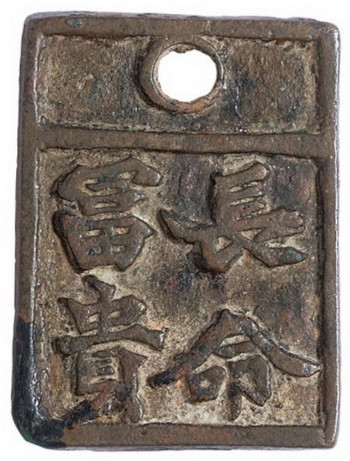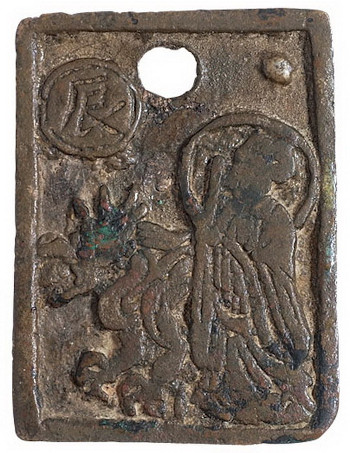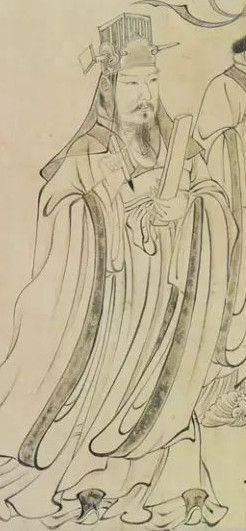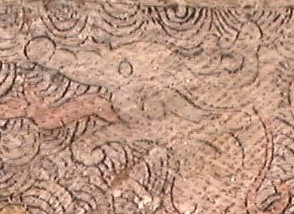One of the most popular ‘good luck’ inscriptions found on old Chinese charms is chang ming fu gui (長命富貴) which is the wish for “long life, riches and honor”.
Shown here is a Song dynasty (宋朝 960-1279 AD) pendant (plaque) charm sold in 2009 by Chengxuan Auctions in Beijing.
The inscription reads as follows: top right (chang 長), bottom right (ming 命), top left (fu 富), bottom left (gui 貴).
An easily overlooked feature of this charm is that the character fu (富), meaning “riches” or “wealth”, is written in an unusual manner.
The character fu is normally written as 富. On this charm, however, the character fu is written as 冨.
Do you see the subtle difference?
The top of the character is written as “冖” (mi “cover”) instead of “宀” (mian “roof”), i.e. the small dot or vertical line at the very top is missing.
Writing the fu character in this manner is known as fu zi wu tou (富字无头) which translates as “fu character without a top or limit”. This implies “riches without an end”. “Endless riches” are, after all, better than mere “riches”!
The reverse side of the charm is shown at left.
On the right side stands a star god known as the Star Official of Dominant Vitality (本命星官).
In Daoist (Taoist 道教) thought, each person is protected by the star god associated with the zodiacal year in which that person was born. (See Daoist Charms.)
The star god is shown with a halo around the head and wearing a long robe.
Clasped in his hands is a hu (笏板).
A hu is a plaque or tablet that is held in front of the chest by officials. It serves as a badge when being received in audience by the emperor. Depending on the rank of the official, the hu can be made of jade, ivory or bamboo.
A drawing of an official holding a hu is shown at the left. This is a detail from a painting by Wu Daozi (吴道子) who was one of the most famous painters of the Tang dynasty (唐朝 618-907 AD).
It is appropriate that a painting by Wu Daozi is used in the discussion of this charm. Some numismatists believe that the depiction of the star god on this charm is in the charming style of Wu Daozi as seen in his “The Eighty-seven Immortals” (八十七神仙圖) painting at the Xu Beihong Memorial Museum (徐悲鴻紀念館) in Beijing.
Continuing with a description of the reverse side of the charm, there is a ferocious dragon on the left side. Only the front half of the dragon is seen because it is standing behind the star god. The dragon is the 5th of the 12 animals of the Chinese zodiac (生肖). Its presence confirms that this star god is the one in charge of those born in the year of the dragon.
The charm’s dragon is similar in style to dragons depicted during the Wei Jin dynasties (220-420 AD).
This similarity in style can be seen in the image at left of a dragon found on a wooden bow discovered in a tomb from the Wei Jin (魏晋) dynasties.
It should be pointed out that in the mouth of dragon on the charm is a large pearl. The pearl is a symbol of riches.
Above the dragon is a round object representing the sun. The Chinese character displayed in the sun is chen (辰) which is the fifth of the Earthly Branches (地支) and refers to the dragon of the Chinese zodiac.
Above the head of the star god is a raised dot representing the moon.
Both the inscription and images confirm that this is a ‘good luck’ charm. In ancient times, this type of charm would have been given to a newborn child or an infant having reached one-month of age (man yue 满月). The charm would have been especially appropriate for a child born in the year of the dragon.
The charm is 31 mm in length and 24.5 mm in width. It sold at the Chengxuan auction in 2009 for $380 (RMB 2464).



